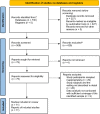Bacterial profile and antimicrobial resistance patterns of infected diabetic foot ulcers in sub-Saharan Africa: a systematic review and meta-analysis
- PMID: 37670001
- PMCID: PMC10480146
- DOI: 10.1038/s41598-023-41882-z
Bacterial profile and antimicrobial resistance patterns of infected diabetic foot ulcers in sub-Saharan Africa: a systematic review and meta-analysis
Abstract
The number of diabetic foot ulcer patients is substantially increasing, with the rapidly rising burden of diabetic mellitus in sub-Saharan Africa. The data on the regional prevalence of diabetic foot ulcer infecting bacteria and their antimicrobial resistance patterns is crucial for its proper management. This systematic review and meta-analysis determined the pooled prevalence of bacterial profiles and antimicrobial resistance patterns of infected diabetic foot ulcers in sub-Saharan Africa. A comprehensive search of the literature was performed on CINAHL, EMBASE, Google Scholar, PubMed, Scopus, and Web of Science databases. Critical appraisal was done using the Joanna Briggs Institute's tool for prevalence studies. A pooled statistical meta-analysis was conducted using STATA Version 17.0. The I2 statistics and Egger's test were used to assess the heterogeneity and publication bias. The pooled prevalence and the corresponding 95% confidence interval of bacterial profiles and their antimicrobial resistance patterns were estimated using a random effect model. Eleven studies with a total of 1174 study participants and 1701 bacteria isolates were included. The pooled prevalence of the most common bacterial isolates obtained from DFU were S. aureus (34.34%), E. coli (21.16%), and P. aeruginosa (20.98%). The highest pooled resistance pattern of S. aureus was towards Gentamicin (57.96%) and Ciprofloxacin (52.45%). E.coli and K. Pneumoniae showed more than a 50% resistance rate for the most common antibiotics tested. Both gram-positive and gram-negative bacteria were associated with diabetic foot ulcers in sub-Saharan Africa. Our findings are important for planning treatment with the appropriate antibiotics in the region. The high antimicrobial resistance prevalence rate indicates the need for context-specific effective strategies aimed at infection prevention and evidence-based alternative therapies.
© 2023. Springer Nature Limited.
Conflict of interest statement
The authors declare no competing interests.
Figures




Similar articles
-
Diabetic foot: A systematic review and meta-analysis on its prevalence and associated factors among patients with diabetes mellitus in a sub-Saharan Africa.Diabetes Res Clin Pract. 2025 Feb;220:111975. doi: 10.1016/j.diabres.2024.111975. Epub 2025 Jan 4. Diabetes Res Clin Pract. 2025. PMID: 39761873
-
Bacterial otitis media in sub-Saharan Africa: a systematic review and meta-analysis.BMC Infect Dis. 2020 Mar 17;20(1):225. doi: 10.1186/s12879-020-4950-y. BMC Infect Dis. 2020. PMID: 32183752 Free PMC article.
-
Bacterial isolates from diabetic foot ulcers and their antimicrobial resistance profile from selected hospitals in Addis Ababa, Ethiopia.Front Endocrinol (Lausanne). 2022 Aug 31;13:987487. doi: 10.3389/fendo.2022.987487. eCollection 2022. Front Endocrinol (Lausanne). 2022. PMID: 36120451 Free PMC article.
-
Prevalence of carbapenem-resistant gram-negative bacteria among neonates suspected for sepsis in Africa: a systematic review and meta-analysis.BMC Infect Dis. 2024 Aug 18;24(1):838. doi: 10.1186/s12879-024-09747-6. BMC Infect Dis. 2024. PMID: 39155370 Free PMC article.
-
Aerobic bacterial profile and antibiotic resistance in patients with diabetic foot infections.Rev Soc Bras Med Trop. 2015 Sep-Oct;48(5):546-54. doi: 10.1590/0037-8682-0146-2015. Rev Soc Bras Med Trop. 2015. PMID: 26516963
Cited by
-
The Microbial Diversity and Antimicrobial Susceptibility Profile Underlying Diabetic Foot Osteomyelitis: A Retrospective Study Conducted in North Queensland, Australia.Foot Ankle Orthop. 2024 Sep 30;9(3):24730114241281503. doi: 10.1177/24730114241281503. eCollection 2024 Jul. Foot Ankle Orthop. 2024. PMID: 39380709 Free PMC article.
-
Complete genome sequence of Staphylococcus aureus strain MD04 isolated from the foot ulcer of a patient with diabetes in rural southwestern Uganda.Microbiol Resour Announc. 2025 Jul 10;14(7):e0036225. doi: 10.1128/mra.00362-25. Epub 2025 Jun 10. Microbiol Resour Announc. 2025. PMID: 40492780 Free PMC article.
-
A systematic review of diabetic foot infections: pathogenesis, diagnosis, and management strategies.Front Clin Diabetes Healthc. 2024 Aug 6;5:1393309. doi: 10.3389/fcdhc.2024.1393309. eCollection 2024. Front Clin Diabetes Healthc. 2024. PMID: 39165660 Free PMC article.
-
Microbial profile of diabetic foot osteomyelitis from the northwest of England.Clin Diabetes Endocrinol. 2024 Nov 9;10(1):35. doi: 10.1186/s40842-024-00193-6. Clin Diabetes Endocrinol. 2024. PMID: 39516954 Free PMC article.
-
Multidrug-Resistant Staphylococcus aureus in Diabetic Foot Infections (DFI) from Beira, Mozambique: Prevalence and Virulence Profile.Infect Drug Resist. 2025 May 31;18:2779-2796. doi: 10.2147/IDR.S521876. eCollection 2025. Infect Drug Resist. 2025. PMID: 40469475 Free PMC article.
References
-
- Atlas, D. International diabetes federation. In IDF Diabetes Atlas, 7th edn. Brussels, Belgium: International Diabetes Federation 33, 2 (2015).
-
- Abbas, Z. G. The Diabetic Foot Worldwide: sub‐Saharan Africa. The foot in diabetes, 51–60 (2020).
Publication types
MeSH terms
Substances
LinkOut - more resources
Full Text Sources
Medical

